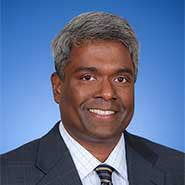NetApp CEO Sees Growth Ahead As Flash, Cloud Solutions Lead The Way

NetApp's fiscal second quarter 2017 revenue and earnings were down but its share price rose more than 10 percent in after-hours trading as investors are starting to see growth in all the right places.
An all-flash storage business that is outgrowing the market and the near-complete shift away from mature products to higher-margin, strategic solutions is leading to optimism at NetApp that sustainable growth is around the corner, despite the emergence of Dell EMC as a "formidable competitor."
NetApp CEO George Kurian told investors that the company's focused and disciplined efforts yielded results for both its top and bottom lines. "These results demonstrate how we are focused on our commitments and dedicated to growth," Kurian said during the Wednesday earnings conference call.
[Related: NetApp Partners: Company Is Primed For Flash Storage, Cloud And The Next-Gen Data Center]
For the fiscal second quarter 2017, which ended October 28, NetApp reported revenues of $1.34 billion, down less than 1 percent from $1.45 billion a year ago.
On a GAAP basis, NetApp reported earnings of $109 million, or 38 cents per share, compared to last year's earnings of $114 million, or 39 cents per share. On a non-GAAP basis, earnings for the recent quarter were $169 million, or 60 cents per share, compared to last year's $181 million, or 61 cents per share.
Krista Macomber, senior analyst at analyst firm Technology Business Research, wrote that NetApp, in response to top-line and bottom-line pressures in the past three to four years, has executed on a number of restructuring activities such as reducing its workforce and focusing on key technology trends including flash storage and clod-based storage.
The changes resulted in a reversal of six consecutive quarters of year-to-year operating margin declines starting last year and have shown success in its investments in its solution and go-to-marketing evolutions, Macomber wrote in a research report on Wednesday.
"As mainstream, incumbent storage provider peers including Dell EMC and Hewlett Packard Enterprise (HPE) complete their stream of acquisitions and divestitures to transform their own businesses, and as niche peers including Nutanix put the pieces in place to execute for broader storage and data center market share, NetApp’s execution in this climate during the next six to 12 months will determine its future in customers’ next-generation data centers," she wrote.
Investors liked the results and NetApp's after-hours share price reflected that optimism.
Kurian told investors that 62 percent of NetApp's total product revenue now comes from strategic solutions, including all-flash storage arrays and Clustered Ontap solutions, with growth in sales of those solutions flat year-over-year because of the strength in last year's second quarter. About 86 percent of NetApp's FAS array shipments are deployed with the Clustered Ontap operating system, up from 70 percent last year, he said.
Meanwhile, NetApp, the second-largest seller of all-flash storage arrays after Dell EMC, is enjoying a growth rate for those products that exceeds that of its competitors and the market as a whole, Kurian said.
All-flash array sales in the second fiscal quarter of 2017 were three-times those of the same period last year, with the majority of growth coming from the company's all-flash FAS line, he said. "We expect to grow share again this quarter," he said.
Revenue from mature products such as OEM sales and solutions based on the company's older operating system fell 28 percent over last year, Kurian said.
Combining the expected growth in strategic solutions with the continual decline in mature products means NetApp can expect to see renewed growth in its business, Kurian said. "We expect this shift to deliver growth in the second half of this year," he said.
Ron Pasek, executive vice president and chief financial officer at NetApp, said during the conference call that NetApp reduced its worldwide headcount by about 6 percent during the quarter.
Kurian, during the question and answer session on the earnings conference call, said the acquisition of EMC by Dell has made Dell a formidable competitor and provided new opportunities for NetApp. "We are taking core customers from Dell EMC," he said.
Dell EMC continues to compete aggressively, Kurian said. "But we see opportunities both in recruiting new channel partners and acquiring new customers," he said.
Kurian also responded to a question about how NetApp is competing against a growing hyper-converged infrastructure market, including solutions from Cisco and Nutanix, by saying that NetApp's relationship with Cisco remains strong, with new FlexPod solutions combining Cisco servers with NetApp's SolidFire all-flash storage arrays. "SolidFire is letting us play in parts of the data center we weren't in before," he said.
NetApp uses FlexPod's automation technology and the SolidFire all-flash storage technology to compete against hyper-converged infrastructure, Kurian said. "The new SolidFire release allows us to compete against hyper-converged in the data center, and we're seeing some wins," he said.
Pasek said NetApp is expecting third fiscal quarter revenue of between $1.325 and $1.475 billion. At the midpoint of that range, that would be a 1 percent increase from the $1.39 billion the company reported in the fiscal third quarter of 2016.